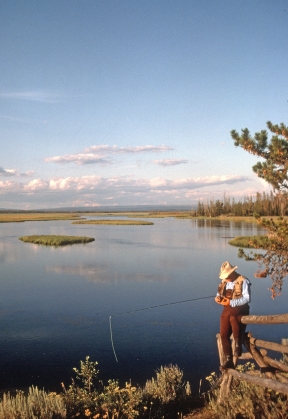
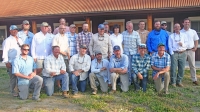
Last week a group of family, friends, customers, former employees and current employees gathered with my wife Sheralee and me at the Harriman State Park to celebrate 40 years since we first incorporated Henry’s Fork Anglers. We shared a spectacular meal followed by a program which featured Dr. Rob Van Kirk, Mark Rockefeller, and Sheralee Lawson. I followed up with a PowerPoint presentation about our history on the Henry’s Fork. I sorted through several thousand slides and photographs to try to find exactly the right photograph to make each specific point. The following evening a few of us gathered again around the fire pit at the Scovel Center to roast some hot dogs and reminisce about days gone by along with our plans for the future.
We apologize to those of you who didn’t know about this event and consequently were not able to join us. Space was very limited and we didn’t send out formal invitations. In fact we kept this so low key that our daughter Jeanette and our oldest son Shaun did not know about it in time for them to plan to attend. By the time they were notified they each had other commitments and weren’t able to join us. We planned for about 60 guests and we ended up with almost 80. Fortunately we were able to make it work and it was a special time for all of us.
Last February I wrote a blog titled “40 Years and Going Strong” about the anniversary event and also about our business and how it came to be. Now that the event is over I’d like to focus on the changes we have seen on the Henry’s Fork and surrounding area over the past 40 years.
Island Park Reservoir
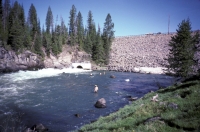
Like any tailwater below a dam, the river is inseparably connected to the lake above. What happens in the reservoir can have a dramatic impact on the river below. I know of nowhere where this has been more evident than the Island Park Reservoir and the Henry’s Fork.
At a maximum capacity of about 135,000 acre feet, the reservoir was completely drained in 1979 when only the river channel flowed through the bowels of the lake. It happened again in 1992. Both years resulted in very high stream flows in the peak of the irrigation season which eventually turned the river turbid and unfishable. There were actually dead chubs and other fish floating through the fowl water and the stench was severe. The 1992 event was far more catastrophic when it was estimated up to 90,000 tons of sediment was flushed into the river.
While both of these years are comparable, I have pondered why the long term damage from sediment was minimal in 1979 when compared to 1992. In 1988 the lush forests of the Upper Henry’s Fork were severely burned along with most of Yellowstone National Park. This left the soil very unstable and over the next several years tons of sediment was washed down into the Upper Henry’s Fork and into the reservoir. Even today the once deep pools of the Upper Henry’s Fork above Mack’s Inn are now filled with sediment. It is logical that the sediment from these fires was flushed through the reservoir and into the river in 1992.
The reservoir was drafted to 12,620 acre feet (9.3%) in 1981 and 11,977 acre feet (8.9%) in 2003. Both years resulted in more turbid, unfishable water for several weeks in the Box Canyon and the Harriman Park. The reservoir was drawn down to less than 20,000 acre feet (<14.8%) in 1984, 2001, 2002, & 2007. The effects of all of these years resulted in high water during July and early August and turbid, sediment laden water later in the season.
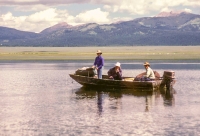
I am hopeful and somewhat optimistic that 2016 will not fall into the category of the prior 8 lowest drawdowns of the reservoir. Currently the Island Park Reservoir is 27,505 acre feet (20.4%). My best guess estimate of inflow is probably somewhere around 500 cfs. Currently outflow is about 800 cfs. As irrigation demand continues to drop off it shouldn’t be too long until outflow matches inflow which could keep the reservoir at or slightly below 20,000 acre feet. While some turbidity always occurs as the reservoir is drawn down, it usually isn’t critical unless it is down to less than 20,000 acre feet.
The Island Park Reservoir has been a major contributor of fish that were flushed through the dam into the river as the lake was drawn down. In fact it is possible that the majority of trout in the river came from the reservoir following the high drawdowns of 1979, 1981, 1984, 1992 and 1994. Prior to 1994 when the hydroelectric facility was completed fish moved freely through the outlet whenever the lake was drawn down. The hydro facility is screened which prevents fish from exiting the lake into the river through the dam. Today some fish are still flushed through the dam. The hydro cannot operate after the reservoir capacity drops 25,000 acre feet.
Dams
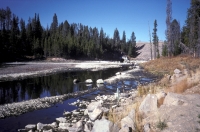
In 40 years in business the greatest impact on the fishery and our business, for good or bad, has been the operation of the Island Park Dam. In the early years the angling community had virtually no say in the management of the dam. In the good years when the snowpack was normal or above, there was enough water released during the winter months to sustain the fishery. Low snowpack meant minimal winter flows. While that is still somewhat the case today, at least the Henry’s Fork Foundation has a voice and a seat at the table. It is also important to note that the angling community is now recognized for its contribution to the economy of the area.
Year in and year out anglers have had to deal with flows that were too low early in the season, too high later in the summer during the irrigation season, off-color water, and low flows in the fall and winter. We’ve had to roll with the flow. In 1976 we knew it going in. We’re in a drought and we’ve been in and out of a drought for most of the 40 years we’ve been in business. Today the natural flow of all of the streams and rivers in the Yellowstone region is far below the normal average. The operation of the Island Park Dam only reflects this fact. You can learn more about this by checking out my blog entitled “The New Normal.”
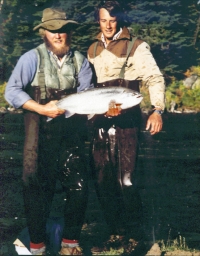
Back when I was a boy it wasn’t unusual for the gates of the dam to be completely shut off at the end of the irrigation season. It happened in October 1979 when the dam was completely shut off for two months. It also happened in the fall of 1984, 1992 and 2003. This leaves fish stranded from the dam downstream to the Buffalo River.
On each of these occasions we were there to salvage and move trout more than 500 yards to the Buffalo River. In 1979 there were only a few of us from Henry’s Fork Anglers and Will Godfrey’s shop. In 1984 we were joined by members of the Upper Snake River Fly Fishers. In 1992 and again in 2003 the Henry’s Fork Foundation spearheaded the salvage operations.
Hydroelectric Development
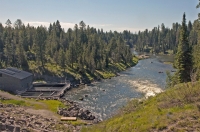
Proposed hydroelectric development that would have likely taken all of the water out of the Henry’s Fork from Riverside Campground to Mesa Falls was the focal point that spawned the birth of the Henry’s Fork Foundation. We were successful in stopping that threat cold in its tracks. At the time we argued against new development but we felt that hydroelectric facilities could be developed at existing dams without negative impacts to the fishery.
In 1992 construction began to retrofit a hydro facility at the Island Park Reservoir. The project was completed in 1994. I served on an advisory committee to ensure safe guards were built into the FERC license to ensure water quality including dissolved oxygen, water temperature, turbidity, and other environmental requirements are met.
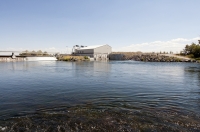
An existing hydroelectric project at the Ashton Dam created another challenge. The dam was old and in 2010 a three year project was initiated to upgrade the dam to modern construction standards. Everything went OK but some minor sword rattling was required to keep the construction effort from flushing sediment into the Henry’s Fork downstream.
The most recent hydro development on the Henry’s Fork is at the Chester Dam. A hydroelectric structure was retrofitted into the Chester Dam in 2014. The construction phase went as expected. The benefits to the river include screening three major diversions which previously allowed hundreds of trout to be lost and a fish ladder for fish migration. The operation of the facility has brought some new challenges but hopefully we’re over the hump. Anglers have had to put up with several serious disruptions that resulted from flushing flows from Island Park Reservoir to test the turbines at Chester. I don’t believe any more testing is acceptable.